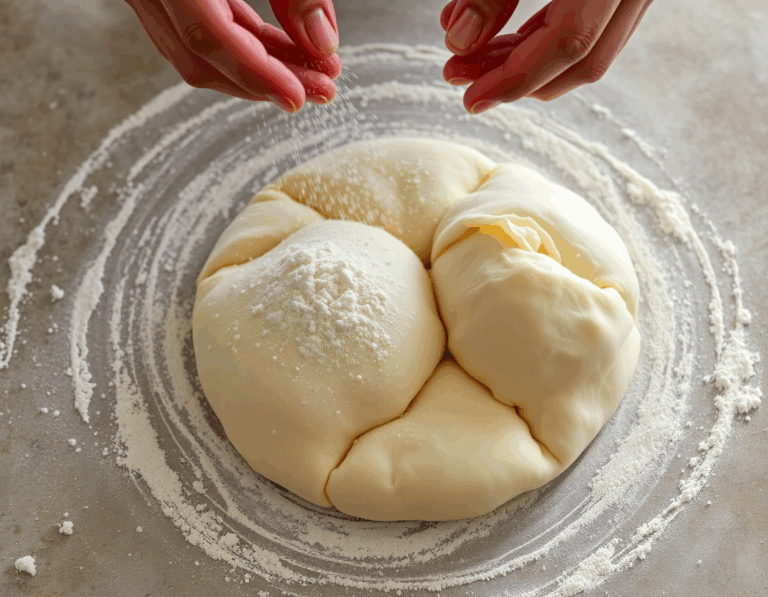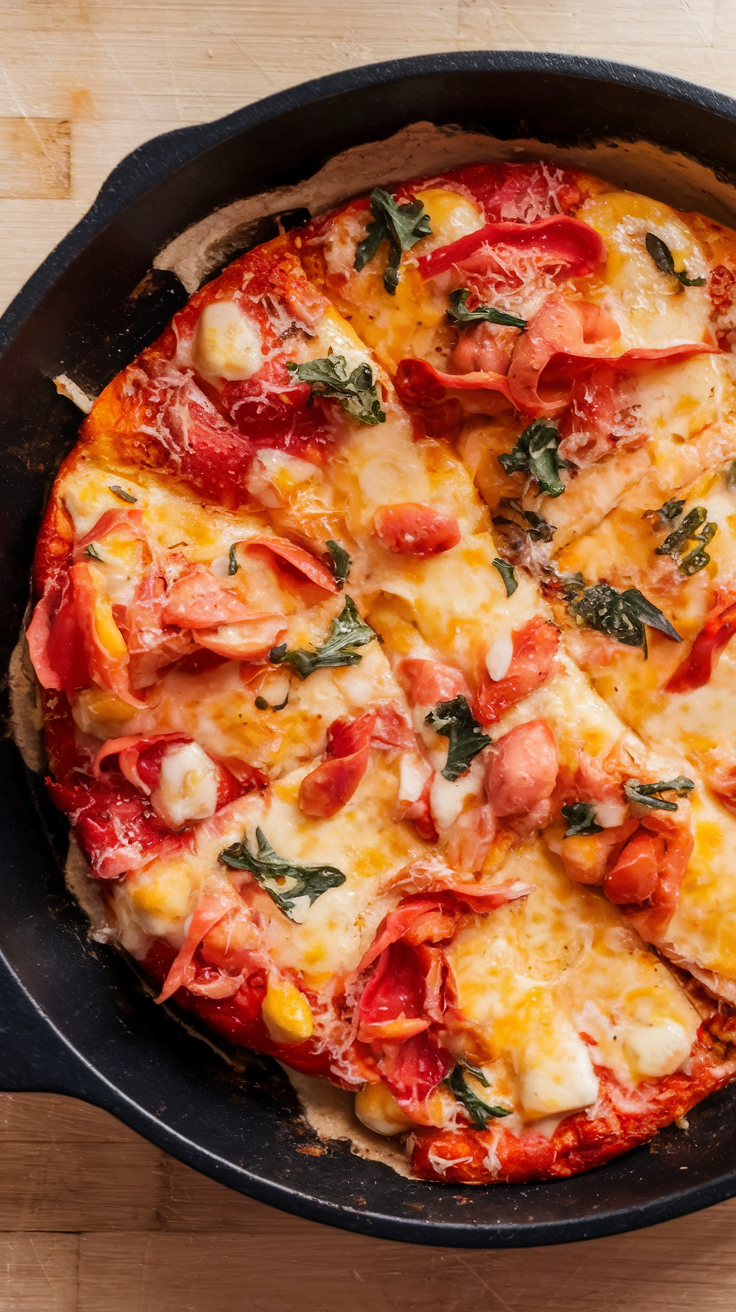There’s something magical about a pizza that doesn’t demand you knead your heart out. Imagine tossing a few ingredients together, letting time do the work, and ending up with a golden, bubbly wonder that fills your kitchen with the smell of Italian dreams. It’s like the lazy person’s guide to culinary heaven—effortless, yet so deeply rewarding, much like finishing a good book on a rainy Sunday afternoon.
Steps
- Mix the Ingredients: In a large bowl, combine bread flour, salt, yeast, water, and olive oil. Stir with your hands or a spoon until no dry flour remains. Cover the bowl tightly with plastic wrap and let it rest at room temperature for 8 to 24 hours.
- Prepare the Dough Balls: After rising, sprinkle flour on the dough and transfer it to a floured surface. Divide the dough into two equal parts and form each piece into a tight ball by tucking the edges underneath.
- Oil the Pan and Proof Again: Add olive oil to the bottom of two 10-inch cast iron skillets or cake pans. Place a dough ball in each pan, coating it in oil, and press it down slightly. Cover with plastic wrap and let it sit at room temperature for 2 hours.
- Shape the Dough: Once the dough has expanded, use your fingertips to press it to the edges of the pan, popping any large air bubbles. Lift the edges to release trapped air beneath the dough.
- Add Sauce and Cheese: Spread approximately ¾ cup of pizza sauce evenly over each dough, reaching the edges. Sprinkle mozzarella cheese over the sauce, and add any other desired toppings. Optionally, drizzle with olive oil and scatter basil leaves on top.
- Bake the Pizza: Preheat the oven to 550°F (290°C) and place the pans inside. Bake for 12 to 15 minutes until the top is golden and bubbly and the bottom is crisp. If needed, crisp the bottom further by placing the pan over medium heat on the stovetop for 1 to 3 minutes.
- Finish and Serve: After baking, sprinkle grated Parmesan or Pecorino Romano cheese on top. Remove the pizzas from the pans, slice them into pieces, and serve immediately.

Ingredients
- 400g bread flour (14 ounces; about 2 1/2 cups), plus extra for dusting
- 10g kosher salt (0.35 ounces; about 2 teaspoons), plus additional for sprinkling
- 4g instant yeast (0.15 ounces; about 1 teaspoon)
- 275g water (9.5 ounces; about 1 cup plus 3 tablespoons)
- 8g extra-virgin olive oil (0.25 ounces; about 2 teaspoons), plus extra to coat pans and for drizzling
- 1 1/2 cups pizza sauce
- 12 ounces grated full-fat, low moisture mozzarella cheese
- Desired toppings
- Small handful of fresh basil leaves, torn (optional)
- 2 ounces grated Parmesan or Pecorino Romano cheese (optional)
FAQ
- What makes this pan pizza recipe foolproof?
- This recipe avoids common pitfalls in pizza-making by eliminating the need for kneading, stretching, and transferring the dough. The no-knead method utilizes time to develop gluten and flavor, while the dough’s high hydration allows it to naturally stretch in the pan without additional effort.
- How does the no-knead method work for pizza dough?
- The no-knead method leverages natural enzymes in flour to break down proteins over time, forming gluten without manual effort. An overnight rise allows yeast to produce gas, helping to stretch and align the proteins, resulting in a strong gluten network and a flavorful dough.
- Why is a cast iron skillet recommended for this recipe?
- A cast iron skillet provides even heat distribution, ensuring the dough bakes into a crispy, golden-brown crust while supporting the pizza’s structure as it rises. The skillet’s surface allows the dough to spread and form an ideal crust without needing a pizza peel or stone.
- What temperature should the oven be set to for baking the pizza?
- The oven should be preheated to a very high temperature of 550°F (290°C) to achieve a crisp exterior with micro bubbles and an airy crumb inside. The high heat causes rapid expansion of air and water vapor inside the dough, enhancing the texture.
- Can I use different types of cheese for the pizza?
- Yes, while mozzarella is traditional, this recipe allows for variations with other good melting cheeses like cheddar, Jack, or young provolone. It’s important to use dry, aged cheeses rather than fresh mozzarella to avoid excess moisture in the pizza.
Tips
- Maximize Flavor and Texture with a Long Rise: Allow your dough to sit at room temperature for 8 to 24 hours. This extended resting period not only reduces the need for kneading but also enhances the flavor and chewiness of the crust through natural gluten development.
- High Hydration for a Better Crumb: Ensure your dough has a water content of at least 60% relative to the flour’s weight. This high hydration level contributes to an airy, hole-filled structure once baked, offering an ideal texture for your pan pizza.
- Avoid Over-Inflated Bubbles: During the final shaping phase, gently press down on any large bubbles in the dough with your fingertips. This prevents them from expanding too much during baking, which can cause the cheese and sauce to slide off.
- Utilize a Hot Oven for Optimal Crispiness: Bake your pizza at the highest temperature your oven can achieve (around 550°F or 290°C) for a crisp crust with a nicely browned and bubbly top. If the bottom isn’t as crisp as desired, finish it off on the stovetop for a few minutes.
Equipment
- Digital Scale: A digital scale with gram measurements to accurately measure the ingredients.
- Cast Iron Skillet: Two 10-inch cast iron skillets for baking the pizzas.
- Round Cake Pan: As an alternative to the cast iron skillet, two 10-inch round cake pans can be used.
- Thin Spatula: A thin spatula for checking the crispness of the crust and removing the pizza from the pan.

